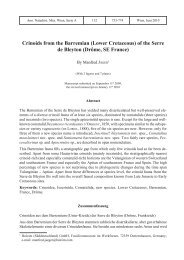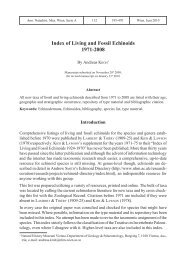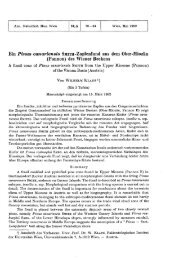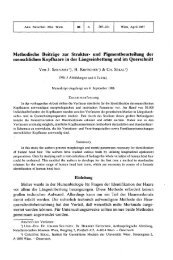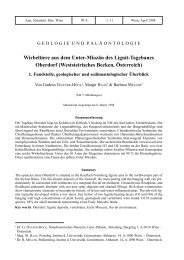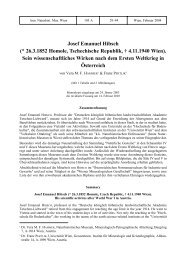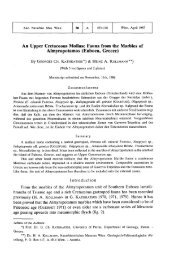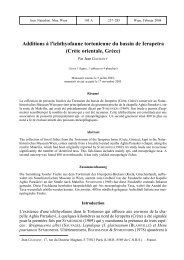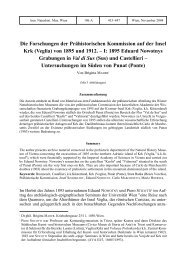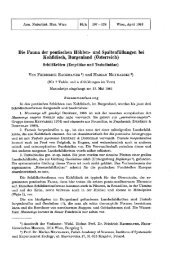Gastropods from the Lower Cretaceous of Vorarlberg, Austria. A ...
Gastropods from the Lower Cretaceous of Vorarlberg, Austria. A ...
Gastropods from the Lower Cretaceous of Vorarlberg, Austria. A ...
Create successful ePaper yourself
Turn your PDF publications into a flip-book with our unique Google optimized e-Paper software.
56 Annalen des Naturhistorischen Museums in Wien 103 A<br />
ROUX, 1847-53, described some <strong>from</strong> <strong>the</strong> department <strong>of</strong> Haute Savoie in France. Several<br />
<strong>of</strong> <strong>the</strong>m have been recorded <strong>from</strong> <strong>the</strong> Swiss Jura (PICTET & CAMPICHE, 1861-64).<br />
Pseudonerinea vaceki has been newly described. The genus Pseudonerinea is represented<br />
in <strong>the</strong> areas mentioned before. The lower diversity may be due to methods <strong>of</strong> collecting<br />
and <strong>the</strong> mode <strong>of</strong> preservation.<br />
The fauna lacks groups which generally are considered as Theian (former Tethyan,<br />
KOLLMANN, in press), such as nerineaceans. Pleurotomariidae, which are generally considered<br />
as Kalaisian ("boreal" or temperate <strong>of</strong> <strong>the</strong> literature, KOLLMANN, in press) are<br />
fairly diverse. The abundance <strong>of</strong> ammonites (see lists <strong>of</strong> HEIM, BAUMBERGER &<br />
FUSSENEGGER, 1933) indicates environments that were bathymetrically deeper than<br />
those <strong>of</strong> nerineaceans, anthozoans, etc. The faunas <strong>of</strong> <strong>the</strong> French departements Yonne<br />
and Aube are generally considered as a bulk, but show quite a variety <strong>of</strong> facies. COLLETÉ<br />
et al., 1995, have compared <strong>the</strong> assemblages <strong>of</strong> various Hauterivian environments <strong>of</strong> <strong>the</strong><br />
Paris Basin and have shown that <strong>the</strong> diversity <strong>of</strong> gastropods and echinoids is diametrical<br />
to that <strong>of</strong> <strong>the</strong> corals. We may conclude <strong>from</strong> <strong>the</strong> composition <strong>of</strong> <strong>the</strong> Gemsmättli gastropod<br />
assemblage that its depositional area belonged to <strong>the</strong> same palaeobiogeographic<br />
unit as <strong>the</strong> Anglo-Paris Basin. According to reefal structures it was part <strong>of</strong> <strong>the</strong> Theian<br />
realm in <strong>the</strong> Valanginian/Hauterivian.<br />
2. Schrattenkalk Formation<br />
The sedimentology <strong>of</strong> <strong>the</strong> Schrattenbach Kalk Formation was discussed by CSASZAR et<br />
al., 1989. Its depositional environments vary between a flat foreslope (Ill section) and<br />
proximal, semirestricted lagoons (Rhomberg Quarry, Unterklien). Naturally, <strong>the</strong> latter<br />
are richer in megafossils.<br />
The following taxa have been recorded <strong>from</strong> <strong>the</strong> Schrattenkalk Formation:<br />
Fissurella sp.<br />
? Scurria sp.<br />
Ataphrus (Ataphrus) reductus COSSMANN<br />
Neritoma (Neridomus) dolichostoma COSSMANN<br />
Otostoma bicostata (VACEK)<br />
Potamides (?Alocaxis) zitteli (VACEK)<br />
Nerineopsis sp. 1<br />
Ceritella (Ceritella) urgonensis VACEK<br />
Plesioptyxis aff. essertensis (PICTET & CAMPICHE)<br />
Pchelincevia indet.<br />
Nerinella sp.<br />
Globularia subtilis (COSSMANN)<br />
Cylindrites cretaceus VACEK<br />
The taxa are closely related to those <strong>of</strong> <strong>the</strong> Urgonian facies <strong>of</strong> France (COSSMANN, 1907,<br />
1916, 1918). However, COSSMANN, 1918, lists 109 species while <strong>the</strong>re are only 13<br />
known <strong>from</strong> <strong>the</strong> Schrattenkalk Formation. This is ei<strong>the</strong>r due to more intensive collecting<br />
or to a larger variety <strong>of</strong> ecological niches in <strong>the</strong> Urgonian platform. In both <strong>the</strong><br />
Schrattenkalk (CZASZAR et al., 1989) and <strong>the</strong> Urgonian platform (MASSE, 1979) gastropods<br />
occur mainly in deposits <strong>of</strong> proximal lagoons toge<strong>the</strong>r with rudists. The scarci-



